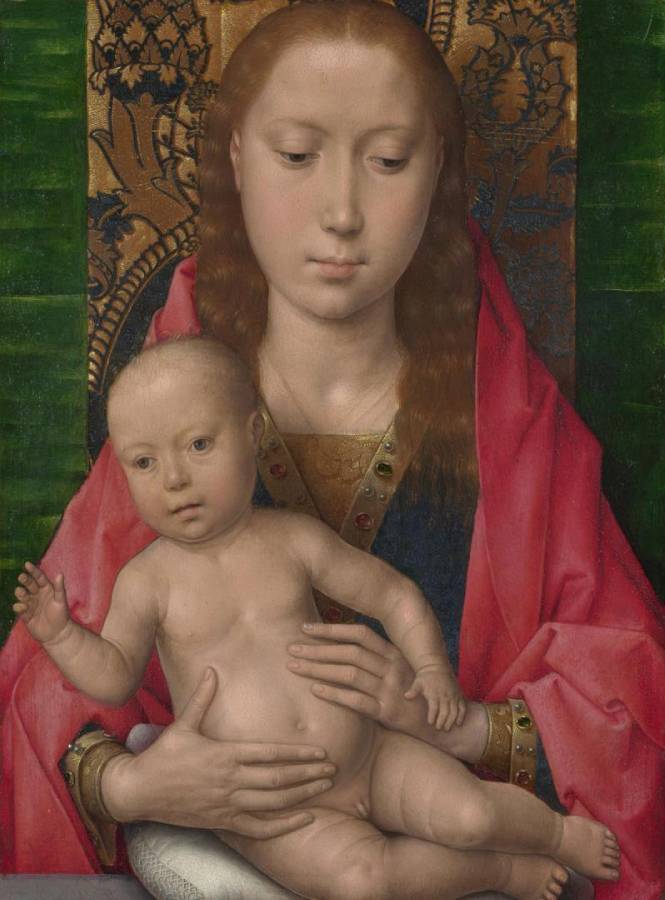Memling, Hans (c.1430-1494)
Virgin and Child
c.1475
Oil on oak, 37.9 x 28 cm
National Gallery, London
The Virgin Mary, bareheaded and richly dressed, holds the naked Christ Child, who rests on a white cushion on a ledge of purple-grey veined stone. The gold that edges her blue overdress is studded with cabochon, or uncut, jewels, and her underdress is of cloth-of-gold. Her bare head and the richness of her dress remind us that she is queen of heaven – queens wore their hair loose and uncovered – while the tiny gold rays around her head stress her divinity. She has an almost invisible transparent scarf around her neck, tucked in to her underdress.
Behind her is a blue and gold brocade cloth of honour edged with strips of green silk, such as would have hung behind medieval kings and queens. Its pattern appears in other paintings by Memling – notably his Triptychs of the Two Saint Johns (Memling Museum, Bruges) – and the motifs are the same or almost the same size. Memling ran a large and well-organised workshop, and tended to recycle designs based on workshop patterns with little variation.
The figures of the Virgin and infant Christ also resemble those in other Memling works. The rather restricted composition can be paralleled in his Man of Sorrows in the arms of the Virgin (National Gallery of Victoria, Melbourne) of 1475. The Virgin’s shoulders are very narrow, but in this and in other respects she resembles the Virgin in the centre panel of the Triptych of Jan Floreins (Memling Museum, Bruges) of 1479. Our painting has sometimes been thought to be by a follower rather than Memling himself, but the very detailed and delicate painting technique is close to that of The Virgin and Child with Saints and Donors (The Donne Triptych). Close inspection reveals that the white catchlights in Christ’s left eye are made up of seven separate brushstrokes.
We are not sure whether the painting was once part of a triptych or stood alone; the Christ Child could be blessing a donor on his right. The panel is almost exactly the same size as Memling’s portraits of Willem Moreel, a prominent Bruges politician, merchant and banker, and his wife Barbara (Royal Museums of Fine Arts of Belgium, Brussels), which were certainly the wings of a triptych. But it is unlikely they flanked this painting, as the Virgin is rather smaller than the two Moreels, and the compositions do not balance. Perhaps Memling was simply using panels of a standard size. Our painting could equally have stood alone, with the infant Christ gesturing and speaking to the viewer rather than a painted donor.
The bare strip of wood around the sides would originally have been covered by the frame, now missing. The reverse is covered with black paint. As this does not quite extend to the edges, it may have been applied when the painting was still in its original frame. (NG)
